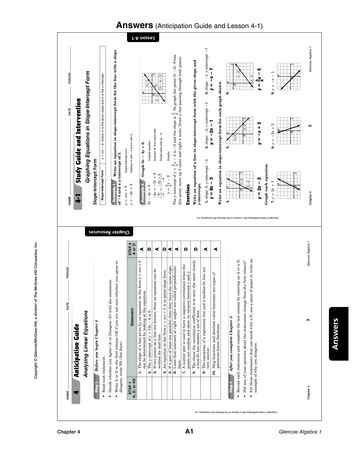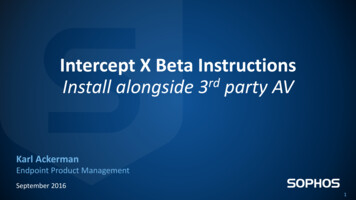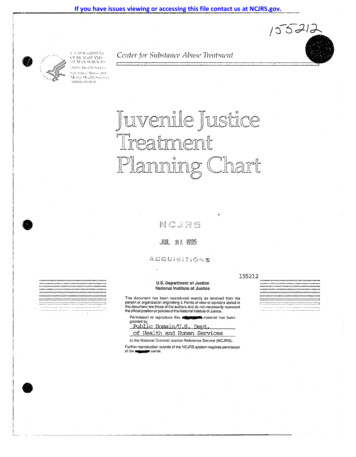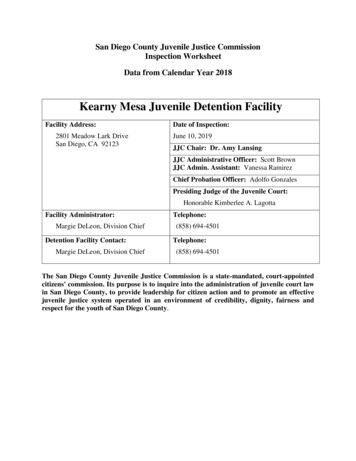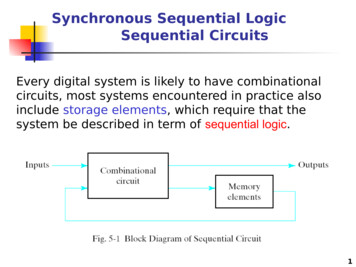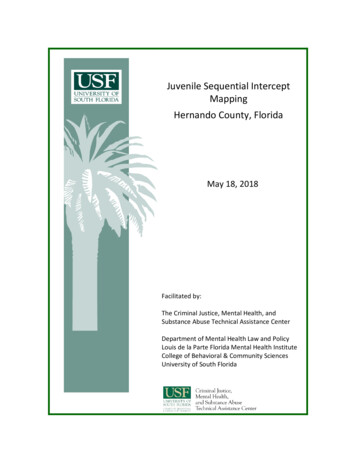
Transcription
Juvenile Sequential InterceptMappingHernando County, FloridaMay 18, 2018Facilitated by:The Criminal Justice, Mental Health, andSubstance Abuse Technical Assistance CenterDepartment of Mental Health Law and PolicyLouis de la Parte Florida Mental Health InstituteCollege of Behavioral & Community SciencesUniversity of South Florida
Hernando County Sequential Intercept Mapping Report AbbreviationsBelow is a list of abbreviations that may be helpful when reading the Hernando County Sequential InterceptMapping (SIM) narrative and map.General List of AbbreviationsADCADPAHCABACCSUCITCJMHSACJMHSA D-VASHJACJARFJDAPJDOJPOLEMAAverage Daily CensusAverage Daily PopulationAgency for Health Care AdministrationBaker ActChildren’s Crisis Stabilization UnitCrisis Intervention TeamCriminal Justice, Mental Health, and Substance AbuseCriminal Justice, Mental Health, and Substance Abuse Technical AssistanceCenterContinuum of CareCentral Receiving SystemCentral Receiving FacilityCrisis Stabilization UnitFlorida Department of Children and FamiliesFlorida Department of Juvenile JusticeEvidence-Based PracticeEmergency Medical ServicesEmergency RoomFlorida Assertive Community Treatment TeamFlorida Department of CorrectionsFlorida Department of Law EnforcementHealth Insurance Portability and Accountability Act of 1996U.S. Department of Housing and Urban DevelopmentU.S. Department of Housing and Urban Development- Veterans AffairsSupportive HousingJuvenile Assessment CenterJuvenile Addictions Receiving FacilityJuvenile Alternative Diversion ProgramJuvenile Detention OfficerJuvenile Probation OfficerLaw EnforcementMarchman Act
MHMHFAMOUNAMIPACTPATSASAMHSIMSMISOARSROUSFVAVOPYES PlanMental HealthMental Health First AidMemorandum of UnderstandingNational Alliance on Mental IllnessPositive Achievement Change Tool Assessment (R-PACT is residential PACT,C-PACT is community PACT)Prevention Assessment Tool (used by FL DJJ in prevention and civil citation programs)Substance AbuseSubstance Abuse and Mental HealthSequential Intercept MappingSerious Mental IllnessSSI/SSDI Outreach, Access, and RecoverySchool Resource OfficerUniversity of South FloridaU.S. Department of Veterans AffairsViolation of ProbationYouth-Empowerment Success Plan (JPOs and case managers use to establishgoals/outcomes with youth and family; also referred to as probation’s case plan);it is becomes part of the Performance Plan when youth transition into the communityHernando County ille Police DepartmentCommunity Reentry TeamDetention Risk Assessment InstrumentHernando County Sheriff’s OfficeLSF Health Systems (Managing Entity)Students with Emotional/Behavioral Disabilities NetworkStatewide Inpatient Psychiatric Program for ChildrenVoluntary Intake Program
Table of ContentsIntroduction. 1Background . 1Objectives of the Sequential Intercept Mapping . 2Keys to Success . 2Hernando County Juvenile Sequential Intercept Map Narrative . 4Intercept 0—Community Services . 4Intercept 1—Law Enforcement & Emergency Services . 6Intercept 2—Initial Detention & Hearings . 11Intercept 3—Jails & Courts . 13Intercept 4—Reentry . 15Intercept 5—Community Supervision . 17Hernando County Priority Areas . 18Hernando County Action Plan . 18Action Planning Process. 18Recommendations . 24Sequential Intercept Map: Hernando County, Florida . 25Appendix A: Participant List . 26Appendix B: Resources . 27Appendix C: Youth Needs Assessment (Hernando Community Coalition) 29
Hernando County, Florida:Transforming Services for Juveniles with Mental Illness andSubstance Use Disorders in Contact with the Juvenile Justice SystemIntroductionThis report provides a summary of the Sequential Intercept Mapping (SIM) held in Hernando County,Florida on May 18, 2018. The SIM provided a strategic plan for a targeted population, namely youthwith substance abuse and/or mental health disorders (SAMH) involved in or at risk of involvement in thejuvenile justice system in Hernando County, FL. Moreover, the SIM is an integrated tool that canfacilitate other community planning related to behavioral healthcare and diversion from the juvenilejustice system or plans to address prevention of youth homelessness. Lutheran Services Florida (LSF)Health Systems (SAMH managing entity and grantee), Hernando County, and the Hernando CommunityCoalition hosted the SIM at the Hernando County Emergency Operations Center (18900 Cortez Blvd.,Brooksville, FL 34601).This report includes: A brief review of the background for the SIMA detailed summary of the information gathered during the SIM, presented by interceptA sequential intercept map developed with input from the participants during the SIMAn action planning (priorities in rank order) matrix developed by the participantsRecommendations to assist LSF Health Systems, Hernando County, and the HernandoCommunity Coalition in achieving their goalsBackgroundLSF Health Systems, the Criminal Justice, Mental Health, and Substance Abuse (CJMHSA) Reinvestmentgrantee for Hernando County, requested the SIM as a top priority in the implementation of a new oneyear planning grant awarded by the Florida Department of Children and Families (DCF) SAMH ProgramOffice. The SIM will assist LSF Health Systems, Hernando County, and the Hernando CommunityCoalition with the activities and products listed below. Creation of a “point-in-time” map of the current juvenile justice system indicating points of“interception” where diversion strategies and programs for youth with SAMH disorders can bedeveloped and implementedIdentification of resources, gaps in services, and opportunities within the existing school system,behavioral healthcare system, law enforcement, and the judiciaryDevelopment of a strategic action plan to implement identified priorities to address juvenilejustice diversion, reentry, and treatment needs of youth with SAMH disorders involved with thejuvenile justice systemThe SIM was comprised of 34 participants representing cross-systems stakeholders including theDepartment of Juvenile Justice, Hernando County School Board members and administration, the FifthJudicial Circuit State Attorney’s Office, the Department of Children and Families, as well as, SAMHtreatment providers, human services, advocates, family members, law enforcement, and court1 Page
administration. A complete list of participants is available in Appendix A at the end of this report. MarkEngelhardt, Karen Mann, and Katelind Halldorsson from the University of South Florida (USF) CriminalJustice, Mental Health, and Substance Abuse Technical Assistance Center (CJMHSA TAC) facilitated themapping. Kareen Ver Helst and Lesley Hersey of LSF Health Systems; Veda Ramirez of Hernando CountyHealth and Human Services; and Tresa Watson, Susan Carrigan, and Lisa Hilko of the HernandoCommunity Coalition organized the logistics of the mapping and provided background information.Appendix B provides a list of website addresses for CJMHSA TAC partners and helpful resources. In late2017, the grantee, LSF Health Systems, contracted with the Hernando Community Coalition (HCC) toconduct a communitywide youth needs assessment. HCC identified the needs of and resources forHernando County youth who experience mental health, emotional, or behavioral crisis that puts them atrisk of entering the juvenile justice system. The needs assessment also incorporated needs and availableresources for children-in-need-of-services (CINS) also referred to as ungovernables or youth in thedependency system. The report, Youth Needs Assessment, was released in January 2018 and is includedin Appendix C.Objectives of the Sequential Intercept MappingThe SIM is based on the Sequential Intercept Model developed by Patricia Griffin, Ph.D. and MarkMunetz, MD for the National GAINS Center for Behavioral Health and Justice Transformation funded bySAMHSA. During the mapping, the facilitators guided participants to identify resources, gaps in services,and opportunities at each of the six distinct intercept points of the juvenile justice system.The SIM has three primary objectives: Development of a comprehensive map of how youth with SAMH disorders flow through sixdistinct intercept points of the Hernando County juvenile justice system: Community Services,Law Enforcement and Emergency Services, Initial Detention and Hearings, Jails and Courts,Reentry, and Community Supervision.Identification of resources, gaps in services, and opportunities at each intercept for youth withSAMH disorders involved in the juvenile justice system (target population).Development of priorities to improve the system and service-level responses for youth.The Hernando County Juvenile SIM map is on page 25.Keys to SuccessExisting Cross-Systems PartnershipsHernando County’s history of collaboration between the behavioral healthcare and juvenile justicesystems is reflected in a number of existing local efforts that were identified prior to and during the SIM.Examples include: Hernando County Public Safety Coordinating Council (PSCC)o Baker Act Marchman Act CommitteeHernando Community CoalitionHernando County Children’s Alliance2 Page
Consumer Involvement The Hernando Chapter of National Alliance for Mental Illness (NAMI) was represented at theHernando County mapping.Representation from Key Decision MakersThe SIM included broad, cross-systems representation and involved many key decision makers. Openingremarks set the stage and established a clear message as to the importance of the SIM and commitmentto an action plan. Opening remarks were provided by: Captain Harold J. Hutchinson Jr., Chair, Public Safety Coordinating Council Shelley Katz, Vice President Operations, LSF Health SystemsDr. Lori Romano, Hernando County Public Schools Superintendent, provided opening remarks for theafternoon session.Lesley Hersey, Community Engagement Specialist, from LSF Health Systems provided closing remarksand thanks participants for attending.3 Page
Hernando County Juvenile Sequential Intercept Map NarrativeThis narrative reflects information gathered during the one-day mapping and often verbatim from theparticipants or local experts. This narrative is a reference guide to navigate the Hernando CountyJuvenile SIM map, especially with regard to acronyms used on the map.Intercept 0—Community ServicesPrevention ProgramsHernando County School District ProgramsIntercept 0 Project StarFISHo The program serves select Hernando County elementaryCommunity Servicesand middle schools.o Project StarFISH, designed to identify and help studentsCrisiswho have a mental illness, works closely with BayCareLinesHealth System (BayCare).o Project SeaHORSE is a similar project proposed for highCrisis Careschool students.Continuum Urban Gentlemen’s Club/Leading Ladies’ Clubo Elementary school students involved in these clubs“dress for success” once a week.o Participating schools have experienced a 60 percentreduction in behavioral incidents. Substance Abuse Intervention Classeso Youth, in school or out of school, “written up” for a first-time controlled substanceoffense may go to the school district’s Substance Abuse Education classes, whichinclude assessments, crisis intervention, educational support, and referral assistance.General Prevention Programs (these programs do not specifically address the target population) Know the Lawo School resource officers educate elementary school students on consequences ofbreaking the law utilizing an evidence-based curriculum. Pace Center for Girlso This “day program” provides academic and social services for at-risk female youth.o It serves approximately 30 female youths in Hernando County. Timber Pines Adult Communityo This is an education program for school-aged youth operated by adult volunteers.o Volunteers have level-two security clearance allowing them to go into the schools.o Volunteers are senior adults and include Veterans. For Each 1 Reach 1 Big Brothers, Big Sisters “Friday Night Done Right”o This program provides safe and supervised activities for middle school-aged studentson Friday nights. The Dawn Center provides teen dating violence prevention and sexual violence education4 Page
Mental Health Awareness Mental Health First Aid (MHFA)o SEDNET, NAMI, Hernando Community Coalition, and BayCare facilitate MHFA trainings.o Three youth trainings in 2018o Lake County’s SAMHSA Project Aware Grant trained five Hernando County MHFAfacilitators.o Approximately 379 individuals have received MHFA training since 2015. Hernando Community Coalition provides mental health awareness for students NAMI’s “Ending the Silence”o Mental health awareness for parents and teachersGaps Hernando County does not have a Children’s Services Council as authorized in s. 125.901, F.S.,funded by county ad valorem taxes through increased mileage rate as a special taxing district.There is limited programming specifically targeting youth with SAMH disorders involved in thejuvenile justice system.There is a need for increased coordination of the county’s prevention efforts, including MHFA.Opportunities As of March 1, 2018, each elementary school has a school resource officer.Hernando County has a Homeless Outreach Team through the Mid Florida Homeless Coalition(there are approximately 543 homeless youths in Hernando County).County support groups (e.g. support groups for grandparents raising their grandchildren)Prevention Partnership Granto Collaborative effort between BayCare, Hernando County School District, Parks andRecreation, and the Hernando Community Coalitiono Grant supports life skills and coping skills training in schoolso Two middle schools have universal and substance use prevention programs5 Page
Intercept 1—Law Enforcement & Emergency ServicesEmergency Services and 911911 If a youth is in an apparent behavioral health crisis and involved witha possible law violation, the Hernando County EmergencyOperations Center (911) operated by Hernando County Sheriff’sOffice (HCSO), is the first point of emergency contact and systemresponse.Law enforcement and Emergency Medical Services (EMS) make theinitial contact in response to a 911 call.o Requesting a Crisis Intervention Team (CIT) officer is possiblewhen contacting 911 but does not guarantee the dispatch ofa CIT-trained officer (while all HCSO officers receive CITtraining, not all municipal officers are CIT-trained).Intercept 1Law Enforcement &Emergency Services911LawEnforcement211 operated by United Way Hernando County has a 211 information and referral service operated by United Way.The 211 Call Center receives calls initiated in Hernando County but also serves Hillsborough andPinellas County, which often results in out-of-county referrals for service.24/7 Access to Care Line operated by LSF Health Systems For 24/7 assistance, a consumer, a family member, or a provider can dial (877) 229-9098.Hernando Cares Behavioral Health Resource Guide The resource guide provides information about mental health and substance use services inHernando County and is available online at hernandocares.org and other locations.Law EnforcementSheriff’s Office Hernando County Sheriff’s Office (HCSO)Municipal Law Enforcement Brooksville Police Department (BPD)Crisis Intervention Team (CIT) Training HCSO hosts the 40-hour CIT training and invites municipal law enforcement officers to attend. There are 180 CIT-trained HCSO personnel (detention center staff, mental health staff, 911dispatchers, and deputies).o 17 of 23 school resource officers (SRO) are CIT-trained. By October 2018, all of the SROswill be CIT-trained. HCSO’s goal is for all personnel to be CIT-trained. There are three CIT trainings scheduled for 2018. HCSO is beginning to keep data on CIT calls and plans to expand the scope of their datacollection.6 Page
Baker Act When a law enforcement officer arrives to an incident involving a juvenile, the law enforcementofficer must determine if the youth in crisis meets the standard for involuntary commitment inaccordance with the Baker Act (Chapter 394, F.S.) or Marchman Act (Chapter 397, F.S.). Thisdetermination is often at the discretion of the officer.o If the youth meets the criteria for an involuntary Baker Act examination, they aretransported to Springbrook Hospital for assessment (applies to youth who havecommitted a misdemeanor or no law violation).o If the youth meets the criteria for a Baker Act, but has committed a felony offense, theyare transported to the Hernando County Jail for assessment. According to the Baker Act Reporting Center at the University of South Florida, in FY2015-16,there were 331 involuntary Baker Act examinations of Hernando County youth. During the 2017-18 school year, HCSO initiated 317 involuntary Baker Act examinations foryouth (through May 18, 2018). Law enforcement’s policy is to handcuff youth during transportation to a Baker Act receivingfacility. Twelve (12) Hernando County youth received crisis stabilization services in FY2015-16, 28 youthreceived services from children’s mobile crisis support, 563 received outpatient services, oneyouth received residential treatment (levels I-IV), and 28 youth received case managementservices (source: LSF Health Systems Clients Data report as stated in Hernando CommunityCoalition’s Youth Needs Assessment report).Marchman Act Law enforcement transports juveniles under a Marchman Act order to the Hernando County Jail. Marchman Act data regarding juveniles was not available at the time of the mapping. In 2016, the Florida Poison Control Center received 161 calls from youth aged six-to-19 years toself-report an overdose.Crisis ServicesSpringbrook Hospital (Hernando County) Springbrook is the only Baker Act receiving facility in Hernando County; while designated foradults, it accepts youth as well—for holding purposes, not for treatment.Springbrook provides a safe, two-room holding area for juveniles until hospital personnelidentifies the nearest children’s Baker Act facility with available capacity (most often placementis out of county).o Youth spend approximately six hours at Springbrook awaiting placement.o During this time, Springbrook is not legally allowed to provide treatment or medicationto youth.o When placement becomes available, Springbrook provides the secondary transport.The nearest children’s Baker Act receiving facility is BayCare’s Morton Plant North Bay HospitalRecovery Center in Lutz (unincorporated area in northwestern Hillsborough County, west ofTampa); however, North Bay has only 1.5 state-funded crisis beds available for HernandoCounty youth. Frequently, Hernando County youth are placed in other facilities, a greaterdistance from home.7 Page
Gracepoint Children’s Crisis Services (Hillsborough County) Provides crisis services for youth (5-to-17 years of age), experiencing an emotional or behavioralhealth illness. A licensed therapist and child psychiatrist provide evaluation, assessment, and inpatienttreatment services. Gracepoint is co-occurring capable and can address secondary substance use issues as well. Inpatient stays are usually 48-to-72 hours.LifeStream Behavioral Center (Lake County) Crisis Stabilization Unit is a six-bed residential facility providing short-term, inpatient treatmentto youth who have a serious, acute psychiatric illness. Serves youth up to the age of 17. Provides short-term inpatient treatment with serious, acute psychiatric illness—illnesses thatcannot be appropriately address with outpatient treatment services.The Centers (Marion County) Children’s Crisis Stabilization Unit provides services for youth experiencing mental healthdistress who may be in danger of harming themselves or others. The Centers has 12 beds for short-term, inpatient treatment.New Beginnings Youth Shelter operated by Florida Network of Youth and Family Services Emergency shelter for youth experiencing abuse, neglect, homelessness, or at-risk behaviors(most often children-in-need-of-services or CINS and youth in the dependency system) Serves Hernando, Sumter, and Citrus Counties 24-hour availability Services include youth supervision, food, clothing, life skills training, crisis counseling, individualand family counseling, recreation, and case management.DetoxificationSpring Gardens Detox (Hernando County) Provides medical stabilization services for individuals (all ages) experiencing drug, alcohol,and/or health-related issues.Substance Use Treatment Services Agency for Community Treatment Services (ACTS), located in Hillsborough County, serves youth13-to-17 years of age. ACTS is co-occurring capable and provides mental health services as well.Operation PAR, located in Pinellas County, provides substance use treatment, includingdetoxification, and serves youth 13-to-17 years of age. Operation PAR will address mentalhealth issues if they are co-occurring (or the secondary disorder).Mental Health Treatment Services LifeStream Behavioral Center-Turning Point Ranch, located in Lake County, is a residential,therapeutic group home for girls (aged 15-to-17) with distinct emotional and behavioralchallenges.BayCare Behavioral Health operates a Statewide Inpatient Psychiatric Program (SIPP) that serves8 Page
youth aged 6-to-8 years in a residential facility located in Pasco County.BayCare Behavioral Health provides targeted case management services and outpatientcounseling (see Intercept 4 Reentry).Diversion Opportunities (In addition, Intercept 2 mentions two are post-arrest/post-plea diversionopportunities)Youth Court Peer-to-peer court that convenes every two weeks An attorney serves, voluntarily, as judge and adult volunteers serve as case managersadministering the Youth Court. Youth Court does not have full-time staff assigned to managethe court and funding is limited. Serves youth 10-to-17 years of age who have committed a first-time misdemeanor offenseo A youth who has committed their second misdemeanor offense may be allowed toparticipate in the Youth Court—such cases are determined on a case-by-case basis.o Exclusionary offenses include sexting, domestic violence, and tobacco offenses There were 181 cases in Youth Court during 2017. Youth Court sanctions include homework assignment related to the crime, fines, and classes atthe Nature Coast High School (e.g., anger management, substance use) Mental health services are not a component of Youth Court. A re-offense or violation of the conditions of Youth Court results in a referral to DJJ and theState Attorney’s Office.Civil Citation Youth aged 14-to-17 who commit a first-time misdemeanor offense may receive a juvenile civilcitation in lieu of arrest. The civil citation program is operated under Hernando County’s YouthCourt. In order to receive a civil citation in lieu of a more formal action/sanction, the youth must agreeto participate in the county’s Youth Court. In calendar year 2017, 191 Hernando County youth were eligible for the civil citation program,of those, 89 were arrested and 102 were issued an alternative to arrest (53%) (Source: DJJwebsite).Gaps Hernando County does not have a children’s crisis stabilization unit (CCSU) or a juvenileaddictions receiving facility (JARF).Due to Hernando County’s lack of residential capacity for youth experiencing a mental healthcrisis, youth are transported and placed out of county for crisis stabilization.There is a no “warm hand-off” when youth return home from a two-to-three-day placement outof county at a CCSU.o Following reentry into the community after an involuntary Baker Act examination,organized care coordination is not available to the youth.Like other rural and/or smaller counties, the Juvenile Assessment Center (JAC) serving HernandoCounty youth is located outside the county in Marion County (Ocala).Probation officers and behavioral healthcare providers experience difficulty meeting with youthin their schools, because schools will not grant them access.o Providers who cannot enter schools to access youth must meet with them during after-9 Page
school-hours and when parents can provide transportation.Provider appointments in the late afternoon and early evening may be more limited,which restricts access to care for youth.Hernando County does not have a mobile crisis team.There is a need to address the future sustainability of the Youth Court (administrative/personnelsupport).o Opportunities Regardless of the nearest children’s Baker Act receiving facility, Springbrook transports theyouth to the facility that has the immediate capacity to accept the youth. Springbrook hasexpressed interest in expanding their capacity to treat juveniles.The Baker Act Marchman Act Committee has been meeting regularly and has a multidisciplinaryapproach to review data with the goal of providing services to youth within the countywhenever possible.o Include emergency room personnel as participants in the Baker Act Marchman ActCommitteeNAMI has a Care Line for consumers and families to access information about services.o Available for calls M-F, 9am-3pmWhen the HCSO receives an abuse call, a school resource officer or deputy conducts a follow-upvisit with the family to provide service referrals.HCSO collects some data on 911 crisis calls in which CIT officers are requested/dispensed.There is a civil citation diversion opportunity for first-time misdemeanant juvenile offenders.10 P a g e
Intercept 2—Initial Detention & HearingsArrest and BookingArrest/Taken into Custody In 2017, there were 406 youths arrested by HCSO in the county,of which, 38 percent (155/406) received referrals to theDepartment of Juvenile Justice (DJJ). DJJ’s Juvenile Assessment Center (JAC) and the Juvenile DetentionCenter are located in Marion County (Ocala).o Youth are transported to the jail to initiate the bookingand intake process.o While the youth is detained at the jail, DJJ personnel atthe JAC telephonically administer the Detention RiskAssessment Instrument (DRAI) to determine the need for(a) secure detention, (b) release on home detention, or(c) release to parent/guardian. If there is a need forsecure detention, the youth is transferred to the JAC inOcala.Intercept 2Initial Detention &HearingsArrestBookingDetentionHearingDetention Hearing The detention hearing occurs in Marion County (location of the JAC and secure detentioncenter) within 24 hours of a youth’s placement in secure detention. This juvenile appears, inperson, in front of a Marion County juvenile judge.The judge reviews the probable cause affidavit and a public defender is appointed at thishearing, if private counsel does not represent the youth.The Judge and State Attorney’s Office review the youth’s self-report substance use screening,the law enforcement probable cause affidavit, and the DJJ juvenile probation officer (JPO)report.At this hearing, the judge determines if the youth should be held or released home.o If the youth is held in secure detention, a date will be set for the arraignment hearing.o If the youth is placed on home detention and released to the parent/legal guardian, DJJintake makes contact with family within 24 hours. The JPO initiates his/her report and,once completed, sends a recommendation to the State Attorney’s Office.Juvenile Assessment Center (referred to as a Screening Unit) The JAC serves Hernando, Sumter, Citrus, Lake, and Marion Counties. The JAC performs a basic mental health screening and administers the Positive AchievementChange Tool (PACT). Once DJJ staff have identified youth that require more screening, LifeStream Behavioral Centerconducts a comprehensive substance use and mental health screening (LifeStream is undercontract with DJJ to provide such services). Approximately 85-to-95 percent of youth self-report suffering from mental health problems.Marion Regional Juvenile Detention (Secure Detention Center) The Juvenile Detention Center serves Hernando, Sumter, Citrus, Lake, and Marion Counties. The Detention Center’s capacity is 41 youth.11 P a g e
The maximum duration in secure detention is 21 days unless a judge orders continued detentionat a subsequent detention hearing. Juveniles awaiting placement in residential programs mustwait for such placement in secure detention.The medical staff at the detention center includes three nurses and one psychiatrist.Mental health services are not offered to youth in secure detention.o The psychiatrist provides services to youth who have been identified as having possiblesuicidal tendencies.o Therapists (contracted and private) are allowed to provide services to juveniles in thedetention center as lon
juvenile justice system The SIM was comprised of 34 participants representing cross-systems stakeholders including the Department of Juvenile Justice, Hernando County School Board members and administration, the Fifth Judicial Circuit State Attorney's Office, the Department of Children and Families, as well as, SAMH
